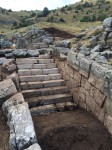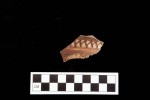 The skeleton of a teenager unearthed on Mount Lykaion in the central Peloponnese region of Arcadia may be evidence that repeated references to human sacrifice in Greek mythology, literature and philosophy may have some truth to them. According to local legend, Zeus was born and raised on Mount Lykaion (Mount Ida in Crete is more commonly cited as his birthplace) and the mountain was sacred to him. Lycaon, the legendary first king of Arcadia, was said to have built a sanctuary to the god on the mountain and sacrificed a human baby to him, spilling its blood on the altar. Other versions of the story have Lycaon roasting parts of his own son or grandson and feeding them to Zeus as a test of his divine powers.
The skeleton of a teenager unearthed on Mount Lykaion in the central Peloponnese region of Arcadia may be evidence that repeated references to human sacrifice in Greek mythology, literature and philosophy may have some truth to them. According to local legend, Zeus was born and raised on Mount Lykaion (Mount Ida in Crete is more commonly cited as his birthplace) and the mountain was sacred to him. Lycaon, the legendary first king of Arcadia, was said to have built a sanctuary to the god on the mountain and sacrificed a human baby to him, spilling its blood on the altar. Other versions of the story have Lycaon roasting parts of his own son or grandson and feeding them to Zeus as a test of his divine powers.
 Whatever the sacrificial method, Zeus was less than pleased, transforming Lycaon into a wolf in punishment. The wolf king’s name is the root of lycanthropy and elements of the myth were incorporated into literary and folk traditions about werewolves. The 2nd century geographer Pausanias in his Description of Greece recounts the myth and finds it persuasive even though later embelishments gave the truthful Lycaon origin story the ring of falsehood.
Whatever the sacrificial method, Zeus was less than pleased, transforming Lycaon into a wolf in punishment. The wolf king’s name is the root of lycanthropy and elements of the myth were incorporated into literary and folk traditions about werewolves. The 2nd century geographer Pausanias in his Description of Greece recounts the myth and finds it persuasive even though later embelishments gave the truthful Lycaon origin story the ring of falsehood.
It is said, for instance, that ever since the time of Lycaon a man has changed into a wolf at the sacrifice to Lycaean Zeus, but that the change is not for life; if, when he is a wolf, he abstains from human flesh, after nine years he becomes a man again, but if he tastes human flesh he remains a beast for ever.
 Werewolf lore aside, there is an ancient sanctuary of Zeus on the southern peak of Mount Lykaion at almost 4,600 feet of altitude. Since 2004, the Mt. Lykaion Excavation and Survey Project, a collaboration of the Ephorate of Prehistoric and Classical Antiquities, the University of Pennsylvania Museum of Archaeology and Anthropology and the University of Arizona, has been surveying and excavating the site, exploring both the upper sanctuary, the sacrificial altar at the peak, and the lower sanctuary, a large complex of monumental buildings including a hippodrome, stadium, baths and an administrative building. The Lykaia festival and games were held there to honor Zeus. They found evidence of use of the Mount Lykaion site — early Helladic pottery sherds — dating back 5,000 years, although there is no indication Zeus was worshipped that early.
Werewolf lore aside, there is an ancient sanctuary of Zeus on the southern peak of Mount Lykaion at almost 4,600 feet of altitude. Since 2004, the Mt. Lykaion Excavation and Survey Project, a collaboration of the Ephorate of Prehistoric and Classical Antiquities, the University of Pennsylvania Museum of Archaeology and Anthropology and the University of Arizona, has been surveying and excavating the site, exploring both the upper sanctuary, the sacrificial altar at the peak, and the lower sanctuary, a large complex of monumental buildings including a hippodrome, stadium, baths and an administrative building. The Lykaia festival and games were held there to honor Zeus. They found evidence of use of the Mount Lykaion site — early Helladic pottery sherds — dating back 5,000 years, although there is no indication Zeus was worshipped that early.
 There is, however, unmistakable evidence of copious animal sacrifices at the upper sanctuary from at least the 16th century B.C. in the Mycenaean period until around 300 B.C.: an ash altar 100 feet broad built up over more than a thousand years of burnt offerings. Tens of thousands of animals, mainly goats and sheep, were sacrificed and burned there for Zeus’ pleasure. This summer, the Mt. Lykaion Excavation and Survey Project discovered a man-made stone platform. Neaby in the ash altar, they found a human burial, the first ever discovered at a sanctuary positively bursting with animal remains.
There is, however, unmistakable evidence of copious animal sacrifices at the upper sanctuary from at least the 16th century B.C. in the Mycenaean period until around 300 B.C.: an ash altar 100 feet broad built up over more than a thousand years of burnt offerings. Tens of thousands of animals, mainly goats and sheep, were sacrificed and burned there for Zeus’ pleasure. This summer, the Mt. Lykaion Excavation and Survey Project discovered a man-made stone platform. Neaby in the ash altar, they found a human burial, the first ever discovered at a sanctuary positively bursting with animal remains.
 The skeleton was on its back in a narrow trench dug into the ash and charred earth. The remains are in good condition, almost intact save for the upper part of the skull which is missing. They belong to an adolescent, probably male. He was laid out on an east-west orientation and both north and south sides of the trench are lined with field stones. More stone slabs cover the pelvis. This burial method is very unusual. Ceramics found buried with the body date to the late Mycenaean period, around the 11th century B.C., during the transition from the late Bronze Age to the early Iron Age.
The skeleton was on its back in a narrow trench dug into the ash and charred earth. The remains are in good condition, almost intact save for the upper part of the skull which is missing. They belong to an adolescent, probably male. He was laid out on an east-west orientation and both north and south sides of the trench are lined with field stones. More stone slabs cover the pelvis. This burial method is very unusual. Ceramics found buried with the body date to the late Mycenaean period, around the 11th century B.C., during the transition from the late Bronze Age to the early Iron Age.
David Gilman Romano, professor of Greek archaeology at the University of Arizona, who participated in the dig on Mount Lykaion said classical writers linked the remote peak with human sacrifice. According to legend, a young boy would be sacrificed with animals, before the human and animal meat was cooked and eaten. “Several ancient literary sources mention rumours that human sacrifice took place at the altar but up until a few weeks ago there has been no trace whatsoever of human bones discovered at the site,” said Romano.
“Whether it’s a sacrifice or not, this is a sacrificial altar … so it’s not a place where you would bury an individual,” he said. “It’s not a cemetery.”
The remains will be studied for confirmation of age, sex, date and hopefully any indications of cause of death. Even if additional analysis is inconclusive, only 7% of the altar has been excavated in four years, so future excavations may answer some questions about how the ancient Greeks sacrificed to their gods. The Mt. Lykaion Excavation and Survey will continue to excavate the site until 2020.